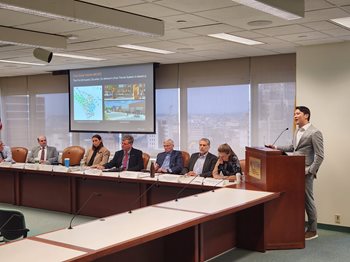Autonomous Vehicles (AV) are being actively tested in select U.S. cities but their widespread use to replace conventional vehicles is a long way off -- perhaps a generation or more. In the meantime, simple things to improve roads for human operators, such as clearer signs and lane markings, will help towns and cities prepare for future AVs.
Those were some of the takeaways from a Symposium on Autonomous Vehicles, hosted by the NJTPA on June 6 in Newark.
A video of selected presentations is here.

AVs were portrayed as a potential means to realize more equitable and sustainable transportation by Jerry He, executive director of the
Corporation for Automated Road Transportation Safety (CARTS), a Princeton-based research nonprofit. His organization is providing technical support for Trenton MOVES, the proposed first AV-based urban transit system in the country.
Trenton MOVES engaged the city’s 90,000 residents over the past two years on designing the proposed system, including the siting of 50 kiosks that will serve as pick-up/drop-off locations for 100 AVs in the city. Companies like Waymo and Cruise have already launched driverless Uber-like services on public roads elsewhere in the country, He said, and other companies are testing and researching their deployment.
Given its population density, He said, North Jersey has a “proof-of-market” opportunity and could lead the nation for equitable deployment of AVs and Autonomous Transit Networks.

Rather than competing with or replacing transit systems, AVs have the power to improve access to traditional bus and rail transit, according to Meghan Grela, Principal-Autonomous Vehicle Lead at
Via, a New York City-based company that runs on-demand microtransit using small vehicles in numerous cities worldwide. AVs she said can serve as an extension of microtransit. “When designed properly, we can make sure AVs are filling gaps in current coverage and not just deploying innovation for innovation’s sake,” she said.
Via operates autonomous microtransit in Grand Rapids, Minn., where it serves senior and disabled populations, and Arlington, Texas, where ridership is comprised mostly of students. Arlington is the first city to rely solely on microtransit, including conventional vans and AVs, for its transit system.
Jack Dean, Program Director, Research & Community Services at NJ Transit, provided insights into the agency’s efforts in testing and evaluating AV shuttles. NJ Transit’s testing location at the former Marlboro Airport in Monmouth County provides a controlled environment for conducting closed-course tests. He said the tests have been promising, with the AVs demonstrating their ability to navigate and respond appropriately in various scenarios such as merging onto main roads, encountering obstacles like garbage cans, and even simulating interactions with pedestrians and animals.

Despite this testing and other efforts around the country, AVs are not on the radar of most municipalities, said Joseph Maraziti, a partner with Maraziti Falcon, LLP in Cedar Knolls and a former chairman of the State Planning Commission. Still, he said towns should prepare for the potential impact of AVs on parking, revenue generation and urban sprawl, while “harnessing the power of public input to create a shared understanding of AV-related changes.”
Matthew Lawson, principal transportation planner for Mercer County, said he had “high hopes but low expectations” for a future involving AVs, suggesting that their most realistic uses may be moving freight on highways. This, he said, might involve automated platooning of trucks down the New Jersey Turnpike, from the port to the warehouses in Mercer County and surrounding areas.
In the meantime, he said other technologies such as improving the operation and coordination of traffic signals – an effort he is pursuing in Trenton and elsewhere in Mercer County -- could benefit mobility while providing needed infrastructure of future AV operations.
Katherine Kortum, senior program officer at the Transportation Research Board (TRB) added a note of caution about the need for investing to prepare for AVs: “Things that are really going to make our system better, are not shiny, sexy, cool things that tech people in San Francisco like to talk about… They’re things like sidewalks, more funding for transit to have more reliability and frequency.”
She said municipalities should focus on simple things like street signage, road markings and consistent infrastructure that humans can understand and use tomorrow, and that AVs can use “when they get here.” She noted that, with the average car in the U.S. today more than 12 years old, it would take 25 years or more for AVs to take over completely if people started buying them tomorrow – which they can’t.
Connectivity, often overlooked in the AV discussion, has more potential than full automation, according to Kortum. “If vehicles can talk to infrastructure and other vehicles, that would get us a large part of the way toward the goals we have that automation might get us to but much more slowly because automation is much more complicated.”
During the question and answer discussion, speakers agreed that flexible approaches to infrastructure – such as designing parking structures that can be reconfigured, upgrading signal technology and accommodating fiber optic cabling – are important for the uncertain transportation future including wider use of AVs.